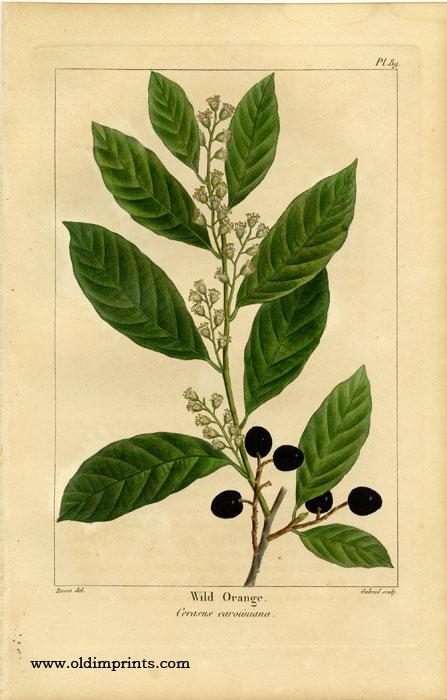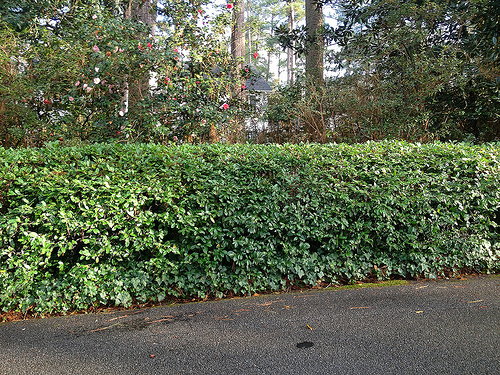But I have been feeling sorry for one particular native tree lately, and thought I would extol its virtues before going on to speak about plants you might actually want to grow…
If I had to give the Rodney Dangerfield award to the native tree that gets the least respect it would certainly go to the common warty-trunked hackberry tree, suffering even more in reputation of late due to a troublesome aphid problem leaving everything below covered by a black mold growing happily in the aphid poop.
But coming in a close second in Dangerfield honors would be our very own native cherry laurel, Prunus caroliniana. Both the hackberry and the cherry laurel are often referred to as trash trees or weed trees. They are definitely not trash, though, given their tremendous success in getting birds to spread their seeds anywhere and everywhere, they can in fact act like weeds. As to what a weed is – and is not – well, that’s for another article.
I cannot dislike any plant whose species name is caroliniana. And I go way back with this prunus…
Growing up on Bridgewood Road we had a volunteer cherry laurel tree right at the back corner of the house, and for years and years it provided very easy access to the roof, much easier than a ladder. The cats even used it for that purpose as well, and I often enjoyed chilling out on the roof with one or more of our cats, thanks to said cherry laurel.
That particular cherry laurel, like most I would guess, grew up amidst stiff competition for light, bending this way and that way. In the end it worked out OK for climbing but it wasn’t particularly photogenic.
We had another cherry laurel that grew up straight as an arrow all by itself, and for some reason we just let it grow. It was in the forward corner of a back quadrant of the back yard that we had long neglected, and served in time to demarcate the civilized from the uncivilized parts of our property. It grew up to be a beautiful, full, and perfectly symmetrical specimen, probably twenty five feet tall by the time I cut it down in 1980 to make room for a lawn I was planting for my parents, imposing civilization upon the woods of the back quadrant. They loved the lawn.
The other things I remember about these two trees were the upright cylindrical blossom arrays (racemes they are called) every spring, the bees swarming around all the white blossoms, and as a result of blooms plus bees, the beautiful black berries every fall.
In my work now I pull out, trim back, cut down, and dig out cherry laurels on quite a regular basis. I suppose that this humble tree contributes quite a bit to my living, so I am grateful to it also in that respect. And thankfully it is very easy to pull out of the ground by hand, compared say to an oak sapling. Even a cherry laurel sapling three to four feet high can be yanked out roots and all, no problem. Try pulling up an oak sapling even half that size. You may pop the sapling, or pop your back, but you won’t pop it out roots and all.
Cherry laurel wood is very heavy due I think to water retention, and has a really attractive red brown color. It stains wonderfully and unpredictably, though I do not know much about its historic use as a wood. For burning I would think it takes a long time to cure. I would be interested to know how it burns once dry since I often produce a prodigious supply!
Though cherry laurels are known for sending up suckers from stumps (almost overnight it seems), the stumps can be killed by brushing with concentrated RoundUp. They can also be dug out if need be.
The reason there are cherry laurels everywhere is of course that their berries are a big hit with the birds. I don’t actually know how many bird species like them, nor, if I were to ask a bird, if cherry laurel would be in its top ten berry list. I do know that the trees are always stripped bare of their berries and that little baby cherry laurels grow far from any mama trees. Somebody likes it. The seed apparently is poisonous but not the flesh of the fruit (technically a drupe). The leaves also are poisonous, which is why deer don’t like them. If you have a deer problem, cherry laurel is a great plant to have around.
Cherry laurels were very common in antebellum southern gardens. They were used for hedges, visual screens and barriers, shade, and often as specimen plants. They were celebrated by none other than the famous Michaux father and son – Andre and Francois – and got a page in Francois’s monumental The North American Sylva, or, A Description of the forest trees of the United States, Canada, and Nova Scotia. Michaux called the plant Wild Orange, and it was also known back then as wild olive. Here is a copy of his engraving of this native tree.
I personally like cherry laurel best when given space and allowed to grow fully in its dark green glory and wonderful oblong tapering shape. I see specimens like this here and there as I drive around. But specimens of this kind are not nearly as common as the crowded bent specimens (which may develop their own twisted gnarly glory as they get older) resulting from early growth among stiff competition. If you have a spot for a cherry laurel, with the space for it develop according to its natural form, it is best to obtain a tree from a local nursery. There are several cultivars, including dwarf varieties, available, such as Monrovia’s Bright ‘N Tight (such a weird name for a plant).
And if you need someone to plant it….



